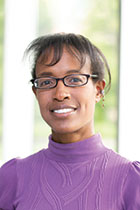Making a Magnetic Impact on the Field
Fall
2022
Singularities - Profiles in Physics
Making a Magnetic Impact on the Field
Korena Di Roma Howley, Contributing Editor
 While growing up in Northern Virginia, Serena Eley came across a story about magnetic levitation trains in a children’s newspaper supplement. The story noted the use of superconductors in various maglev train designs, so Eley turned to her family’s Encyclopedia Britannica volumes to learn more about superconductors. But the Britannica entries only went so far in answering her questions, and she realized that it might take several years—if not a lifetime—to thoroughly understand the topic.
While growing up in Northern Virginia, Serena Eley came across a story about magnetic levitation trains in a children’s newspaper supplement. The story noted the use of superconductors in various maglev train designs, so Eley turned to her family’s Encyclopedia Britannica volumes to learn more about superconductors. But the Britannica entries only went so far in answering her questions, and she realized that it might take several years—if not a lifetime—to thoroughly understand the topic.
After further research, Eley understood the impact of superconductors on transportation and could infer their potential impact on power applications. Later, as a physics student, she came to realize that superconductors with specific properties could also be transformative for magnets and devices.
Today, Eley is a physics professor who studies superconductors, magnetic materials, and superconducting quantum circuits. Her research looks into how the microscopic defects within a material’s structure influence its properties and how those influences can be minimized or harnessed.
“The general goal,” she says, “is to learn how to optimize the material disorder landscape to improve properties for applications, which may enable, for example, superconducting magnets capable of higher magnetic fields and skyrmion-based spintronic devices.”
Such spintronic devices have the potential for storing much more information than conventional electronics in a much smaller space and with less power.
“I really enjoy research, solving problems that have no known solution,” Eley says. Even the day-to-day aspects of her career bring rewards. “I like the challenges of troubleshooting experiments and processes,” she says. “I also love learning about the frontiers of research and hearing about clever approaches at conferences and workshops, as well as collaborating internationally.”
In addition to research, Eley is passionate about mentorship and its importance in the field of physics. “We cannot solve the toughest, most compelling problems in a vacuum,” she says. “Yet physics is not a welcoming field. It tends to have a bit of an elitist culture that not only serves as a deterrent for many who try to enter the field but also partially accounts for a fairly prevalent fear of physics among our nonphysicist friends.”
In addition to helping students navigate these challenges, Eley says a good mentor can provide strategies for securing opportunities, as well as advice that directly results in measurable, career-improving accomplishments. Her own mentors paved the way for opportunities that led to her academic career. Now, as a teacher and mentor, Eley finds it particularly rewarding to see students apply what they’ve learned in her courses and research lab to real-world internship opportunities.
In recognition of her contributions to physics, Eley was named the recipient of the 2021 Joseph A. Johnson III Award for Excellence by the American Institute of Physics and the National Society of Black Physicists (NSBP). Now in its second year, the award is granted to early career scientists who exemplify the values of Joseph A. Johnson, a renowned experimental physicist, impactful mentor, and founder of NSBP.
With the award, Eley plans to continue her dedication to undergraduate research opportunities. After four years at the Colorado School of Mines, where she mentored 23 undergraduate researchers, in January 2023 Eley will begin a faculty position at the University of Washington.
Eley encourages undergraduates to take advantage of available opportunities, even if they don’t feel ready yet. “A lot of early physics students fear that they don’t have useful skills to secure an internship, and they wait until later in their undergraduate careers to apply,” she says. “My advice is that it’s never too early to apply and to participate in technical internships every summer. Use these opportunities to boost your resume, learn new skills, and help determine your career path, but don’t forget to also prioritize contributing to the goals of a research program or industry position.” She urges students to avoid overcommitting, however. “Accepting multiple research positions or research and teaching assistantships restricts your ability to take ownership of your commitments and fully contribute.”
And, of course, Eley encourages mentorships. The best way to find a mentor, she says, is simply to schedule meetings with professors or other scientists to casually discuss their research and your career goals. “For experimentalists,” she says, “just ask to see the lab. We love showing our labs. And when you find someone who seems truly interested and excited to provide advice to you, ask them to be your mentor.”
The National Society of Black Physicists (NSBP)
The mission of NSPB is to promote the professional well-being of African American physicists and physics students within the international scientific community and within society at large. To learn more, visit the NSBP website
at nsbp.org.
Student members of SPS are eligible for free membership in NSBP. For details, see spsnational.org/about/partnerships/nsbp.
